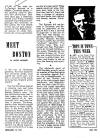
|
MEET BOSTON Friday, December 19, 1941 in What's New In Town W. J. Sidis |
One of the most important features of a modern Christmas season―the greeting card―is Boston’s own contribution. Over sixty years ago, a Bostonian named Louis Prong invented a process of printing color engravings―the “Chromos” of that period. His first efforts at this new art were engraving bits of New England winter scenery on cards, combined with various sentiments in the way of Christmas greetings. And thus arose the first Christmas Cards, since copied the world over, and still, in all parts of the world, carrying New England winter scenery.
*
The first Christmas festival in America may well have been celebrated within Greater Boston’s area. For the old Scandinavians had, in their pagan days, their own winter festival of Jul (pronounced Yule) and, even before it became Christmas, settlers from Iceland brought this festival to these shores. Back in the Arctic parts of Scandinavia there was regular rejoicing at the birth of a new sun after the short period of winter darkness―this would be the last part of December. As celebrated in the warmer climate of their Vinland settlement (at Mount Auburn), it was not the birth of a new sun but of a new world. These people could not know that, even then, back in the Iceland they had left, there had been a change of religions, and back home, their festival had already become Christmas.
*
The Puritans did not believe in Christmas, and forbade its celebration on the ground that it was a survival of paganism. It was not till 1852 that that holiday received recognition in Massachusetts. However, this does not go to justify the common “sourpuss” reputation the Puritans have. They put enough into their Thanksgiving to do for both holidays―the reason Thanksgiving has customarily been on Thursday was, among Puritans and Pilgrims, to allow Friday, Saturday, and Sunday to rest up from the feasting and rejoicing.
*
The witchcraft panic of 1692 has been unjustly set up by enemies of New England as an accusation against Puritan rule in Massachusetts. In point of fact, Puritan rule had at the time already been overthrown, and Massachusetts was then ruled by governors and judges appointed from across the ocean, and out to terrorize Puritan lands. In the sixty years of the Puritan regime, there had been only about a dozen witchcraft accusations, and, in many of these, the result was a libel suit against the accuser. The persecution of 1692 ended in a short time, as soon as Puritan juries agreed to refuse to convict. At first, the judges would order the jury back with instructions to find a verdict of guilty; then the Puritans refused to obey even these instructions. This created the precedent in America that a judge cannot order a jury to convict anyone.